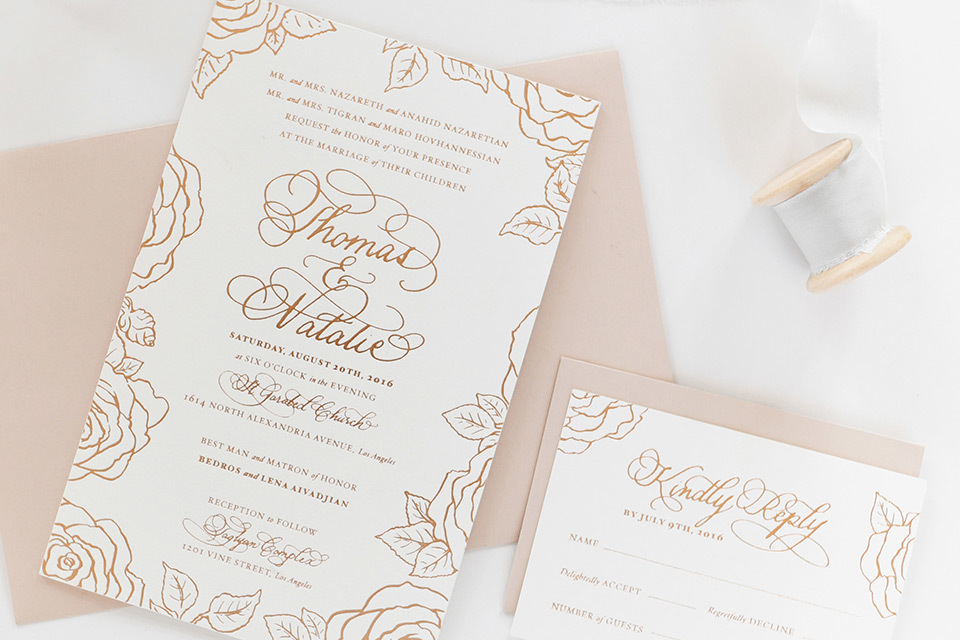Wedding Invitations Glossary
Um. What's a belly band?

Shopping for wedding invitations? Well you're in luck! We've put together a glossary of common printing terms you may encounter as you research wedding invitation options. Because WTF is thermography.
Printing Terms
- Letterpress:
Letterpress printing dates back to the 14th century, and involves inking the raised surface of metal type or custom-engraved plates and then applying the inked surface against paper with a press. When used with the right paper (thick, softer paper results in a deeper impression), fonts and colors, letterpress creates an elegant product with a stamped, tactile quality. This process offers lots of options, but can cost more than other methods. Also, photographs and metallic inks generally don’t work well with letterpress.
- Embossing:
Using a metal die, letters and images are pressed into the paper from behind, creating a raised “relief” surface, imparting added dimension to the invitation design. Usually used for large initials or borders. Ink or foil may be applied to the front of the paper so that the raised letters and images are colored.
- Blind embossing:
No ink or foil is applied, so the embossed (raised) image is the same color as the paper.
- Thermography:
This popular printing method uses heat to fuse ink and resinous powder, producing raised lettering. Though it looks almost exactly like engraved printing, thermography is much less expensive. This process will not reproduce detail as sharply as engraving will. The powder is added after the ink is applied, generally with an offset press, so the use of paper or metal offset plates affects quality here, too.
- Engraving:
Engraving is generally the most formal and expensive printing option. The image is etched into a metal plate, and the ink held in the etched grooves is applied to the paper with a press. The resulting raised image is comprised entirely of ink sitting on the surface of the paper. The ink applied is opaque, making it possible to print a lighter colored ink on a darker colored paper with this method. Engraving is not the best printing choice if you have a photo or illustration that requires a screen.
- Offset printing:
Most printing these days is offset, which means the original image is transferred from a plate to a drum before it is transferred to the paper. This process produces print that sits flat on the surface. There are many levels of quality with this method: If your printer uses paper printing plates, the job will cost less but the result may be fuzzy, inconsistent lettering. Metal plates yield much sharper, crisper type.
- Digital printing:
In this method the computer is linked to the printing press and the image is applied to paper or another material directly from a digital file rather than using film and/or plates. Digital is best for short-run, quick jobs. This can also be a good option if you want to use full color.
- Foil stamping:
Foil is applied to the front side of the paper, stamped on with a metal die. Foils can be metallic or colored, shiny or dull. They are usually very opaque, and this is a great way to print white on a dark colored paper.
- Calligraphy:
This is the perfected art of writing by hand. Often associated with fancy, curlicue script, calligraphy is comprised of several genres and styles.
Paper Terms
- Matte:
A paper coating that’s flat and non-reflective (no gloss).
- Jacquard:
Screen-printed paper that creates an illusion of layering; for example, paper that looks like it’s overlaid with a swatch of lace.
- Parchment paper:
This paper is somewhat translucent and often a bit mottled to mimic the appearance of ancient, historical documents made out of animal skins. It’s excellent for calligraphy.
- Linen finish:
Paper with a surface that actually mimics linen fabric. If you look closely, you see lines of texture going both horizontally and vertically on the surface.
- Rice paper:
Not actually made of rice, this paper is extremely thin and elegant.
- Glassine:
A very thin, waxy paper. Thinner than vellum (see below), its surface is slick and shiny, whereas vellum is more translucent. Glassine is best suited for envelope use, while vellum is sturdy enough to be printed on directly for invitation use.
- Vellum paper:
A heavier, finely textured translucent paper made from wood fiber. Similar to parchment, it was originally made from the skin of a calf, lamb or baby goat and used for writing and painting during the pre-printing age.
Read more about wedding invitations!
- Brides Want To Know: Guessing the Guest Count
- Useful Tips for Ordering Your Wedding Invitations
- 21 Questions to Ask When Ordering Your Wedding Invitations
Are we friends yet? Join MyGuide for more goodness!
Some clients may have paid to be placed in our editorial and some of these links may be affiliate; however, we never include a venue, vendor, or product unless they have a proper place here. This is part of our Core Values. We create our website first and foremost to be good for the couples using it to plan their Big Day. We won't stray from that for a few advertising dollars. #scoutshonor

